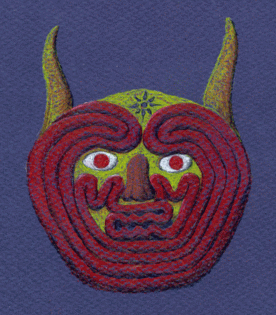The Ritual of the Labyrinth
Ta Hiera Laburinthou
©1997, John Opsopaus


I call on Thee, kind Muse, to grant a gift,
to loose a stream of swiftly flowing words,
a spring of inspiration, crystal clear,
to nourish fruit from which to feed the soul,
a rushing stream to cleanse my inner eyes
so I may see the ageless mythic truth.
I ask assistance by these very words.
As I have prayed, so may it be!
![[Theseus and Minotaur image]](images/Minotaur1-small.gif) The Ritual of the Labyrinth draws from a number of
connected or parallel sources.[2] First, of course, we have the
myth of Theseus, Ariadne and the Minotaur, in the various
forms in which it has come down to us.[3] Second is a series of
ancient Greek festivals connected with this myth, which occur
around November 1 at the time of the Moon's first quarter (the
Puanepsia, Oskhophoria and Theseia), when Apollo yields to
Dionysos at Delphi.[4] Third is a connection of the myth with the
Epic of Gilgamesh.[5] Of course they are both
representatives of the Hero's Quest (as in Campbell's Hero
with a Thousand Faces), but there is a more specific
connection. Humbaba (or Humwawa or Kombabos), the monster
defeated by Gilgamesh and his comrade Enkidu, is traditionally
shown with a grotesque "furrowed face," taken to represent the
small intestines.[6] The entrails are "unicursal" like the Cretan
Labyrinth (that is, there is a single path), and indeed the
number and arrangement of the coils is essentially that of the
Labyrinth
(see Minotaur Mask).
Likewise, the Cretan Labyrinth is compared to entrails.[7]
Furthermore, the Face of Humbaba was used for divination,[8]
and the shape and divisions of divinatory livers from Babylonia
correspond closely to the Cretan Labyrinth
(see Labyrinths).[9]
Humbaba is the guardian of a Sacred Tree, and it does not
seem coincidental that we find similar "furrowed face" masks in
the shrine of Ortheia (the Upright Tree), where there were
labyrinthine dances involving a defeated monster, a Sacred
Tree, and a Sacred Marriage between a Hero and a Goddess (cf.
Gilgamesh and Ishtar/Inanna).[10] The Goddess Ortheia was most
closely associated with Artemis and Aphrodite, who have
important roles in the Ariadne story.[11] The fourth source is the
Mistress of the Beasts and Her Consort from Minoan Religion.[12]
The final (principal) source is medieval labyrinth dancing and
other labyrinthine lore that has come down to us.[13] Other
themes come from the identification of Ariadne with
Persephone as Queen of the Underworld (reinforced by Minos'
role as judge in the Underworld).[14] (More specific sources are
given in the notes.)
The Ritual of the Labyrinth draws from a number of
connected or parallel sources.[2] First, of course, we have the
myth of Theseus, Ariadne and the Minotaur, in the various
forms in which it has come down to us.[3] Second is a series of
ancient Greek festivals connected with this myth, which occur
around November 1 at the time of the Moon's first quarter (the
Puanepsia, Oskhophoria and Theseia), when Apollo yields to
Dionysos at Delphi.[4] Third is a connection of the myth with the
Epic of Gilgamesh.[5] Of course they are both
representatives of the Hero's Quest (as in Campbell's Hero
with a Thousand Faces), but there is a more specific
connection. Humbaba (or Humwawa or Kombabos), the monster
defeated by Gilgamesh and his comrade Enkidu, is traditionally
shown with a grotesque "furrowed face," taken to represent the
small intestines.[6] The entrails are "unicursal" like the Cretan
Labyrinth (that is, there is a single path), and indeed the
number and arrangement of the coils is essentially that of the
Labyrinth
(see Minotaur Mask).
Likewise, the Cretan Labyrinth is compared to entrails.[7]
Furthermore, the Face of Humbaba was used for divination,[8]
and the shape and divisions of divinatory livers from Babylonia
correspond closely to the Cretan Labyrinth
(see Labyrinths).[9]
Humbaba is the guardian of a Sacred Tree, and it does not
seem coincidental that we find similar "furrowed face" masks in
the shrine of Ortheia (the Upright Tree), where there were
labyrinthine dances involving a defeated monster, a Sacred
Tree, and a Sacred Marriage between a Hero and a Goddess (cf.
Gilgamesh and Ishtar/Inanna).[10] The Goddess Ortheia was most
closely associated with Artemis and Aphrodite, who have
important roles in the Ariadne story.[11] The fourth source is the
Mistress of the Beasts and Her Consort from Minoan Religion.[12]
The final (principal) source is medieval labyrinth dancing and
other labyrinthine lore that has come down to us.[13] Other
themes come from the identification of Ariadne with
Persephone as Queen of the Underworld (reinforced by Minos'
role as judge in the Underworld).[14] (More specific sources are
given in the notes.)

This ritual is ©1997, John Opsopaus, but may be used for any nonprofit purpose provided the source is credited.
![]() Return to Biblioteca Arcana page
Return to Biblioteca Arcana page
 Send comments about this page
Send comments about this page